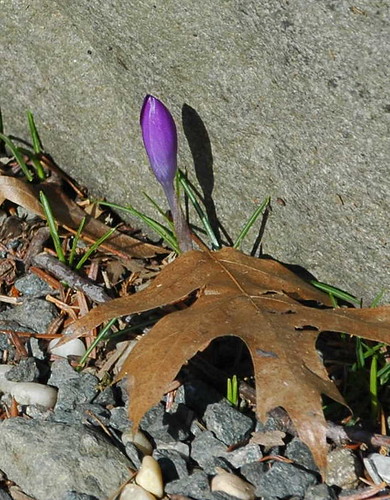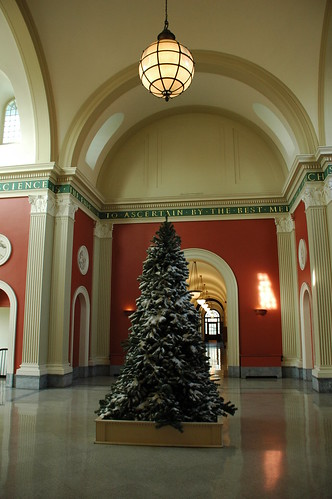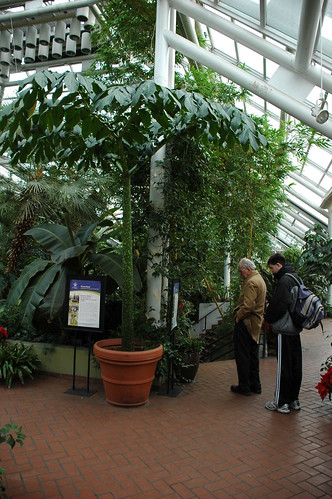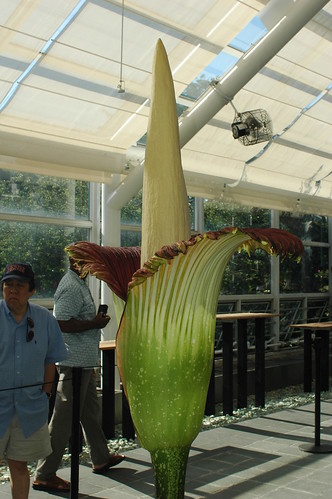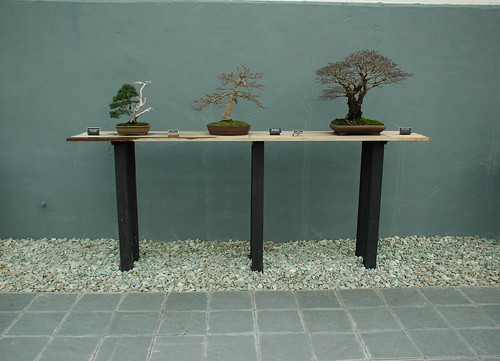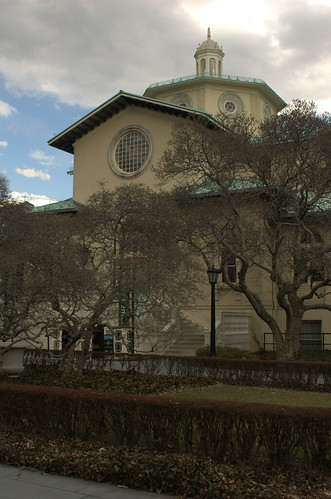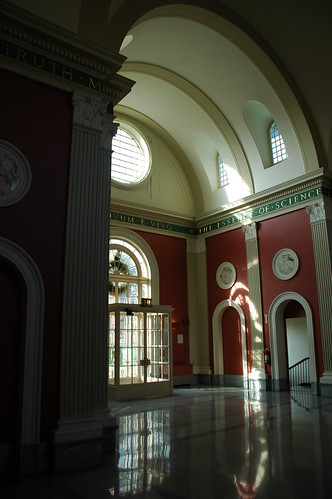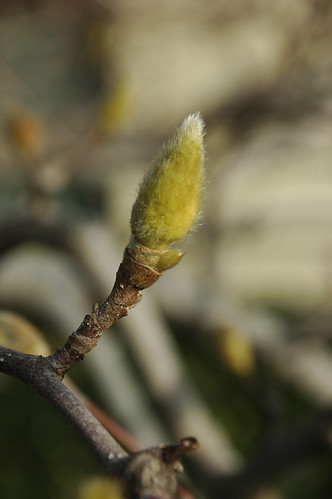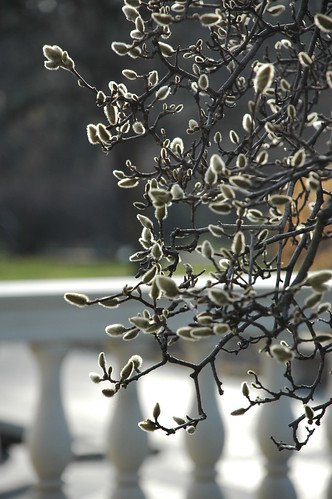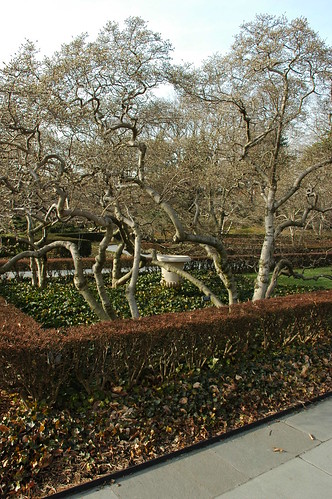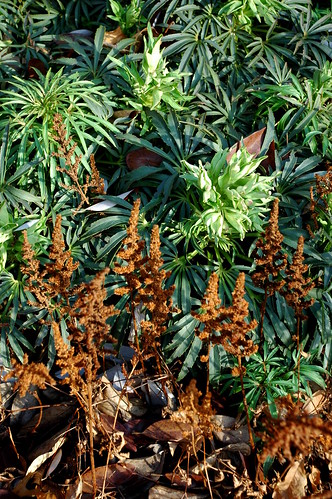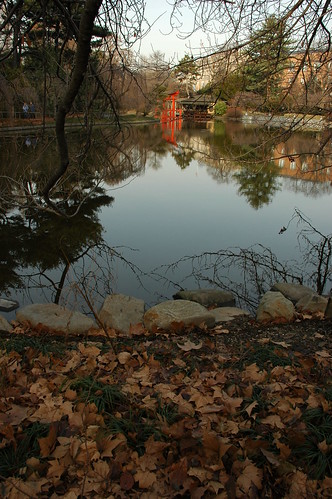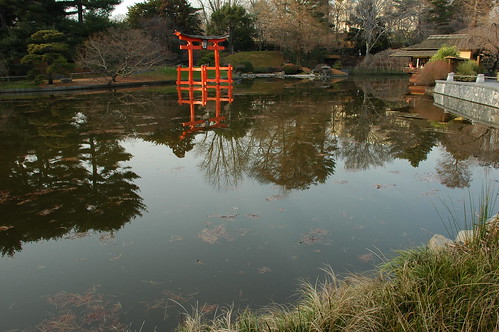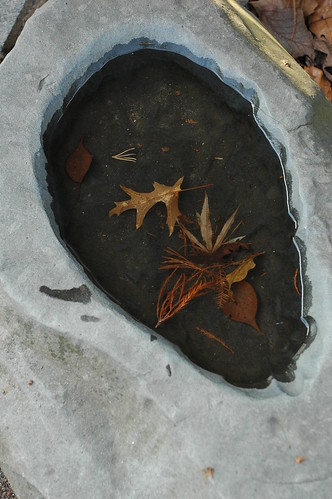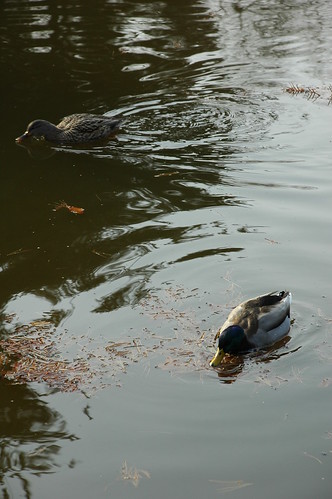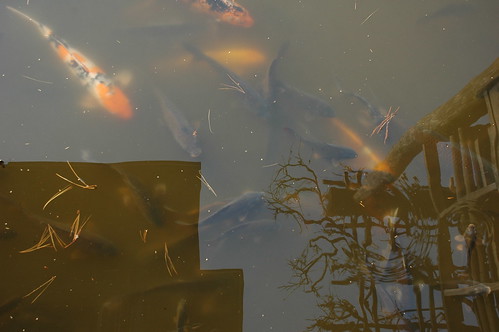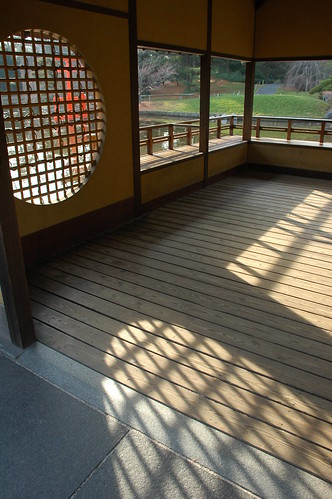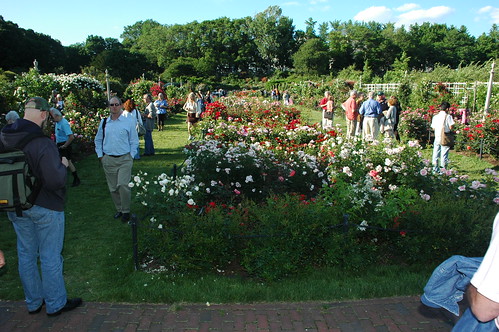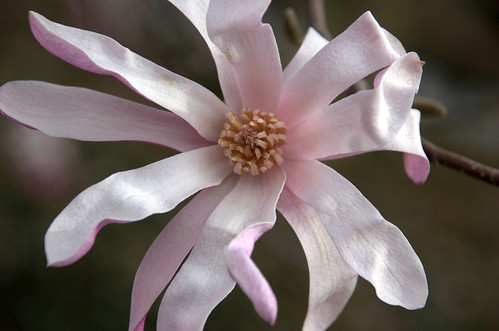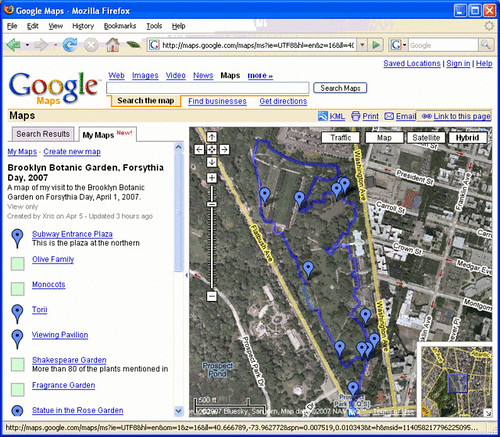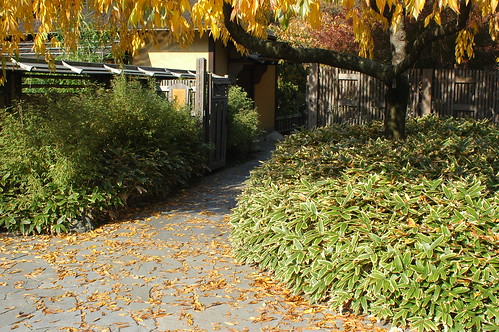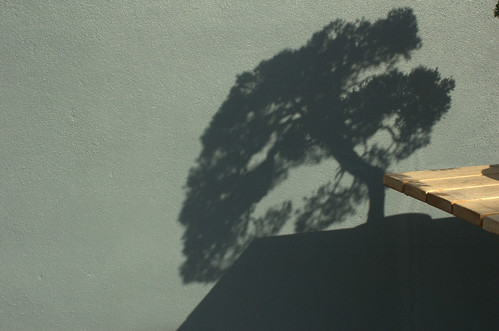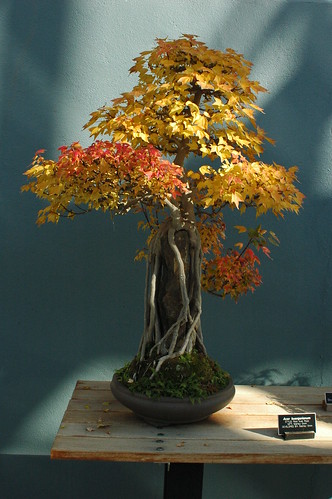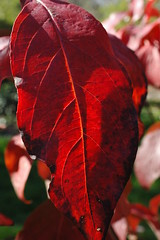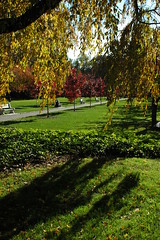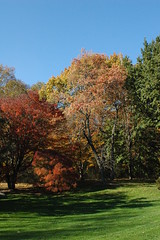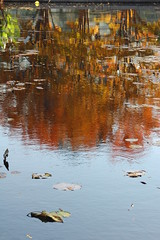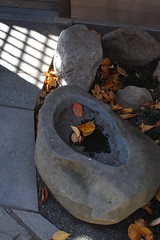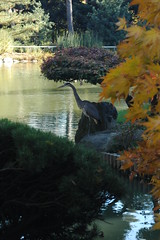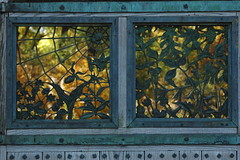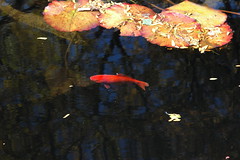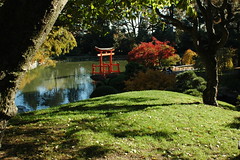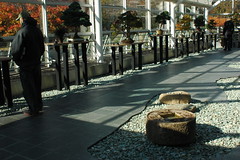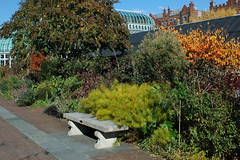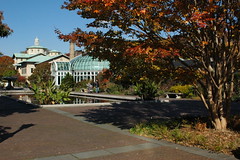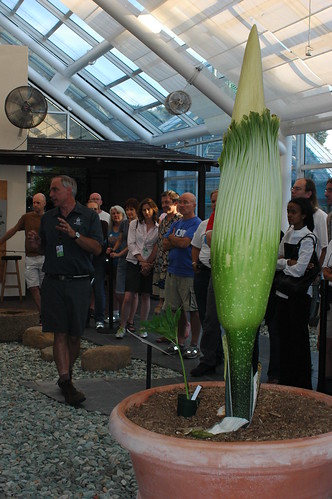[Update, August 15, 2006: BBG requested permission to use some of these photos on their Web site! Check out their A. titanum Photo Gallery for August 14, 2006.]
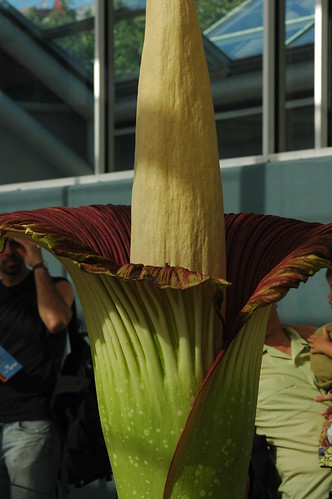
“Baby” picture.
I doubt anyone’s been waiting breathlessly by their RSS or Atom feeds for my report. Last night, I had to crash early, and today was a picture-perfect day, so I got some gardening work done outside. Nevertheless, I apologize for my tardiness. In the meantime, I hope you’ve checked out the photos I took yesterday (technically, two calendar days ago, as it’s already past midnight Saturday night). I’ll highlight some of them here.
When I blogged Thursday night, after following the dramatic changes in the bloom on BBG’s Web Cam, I had hoped I would be able to get there as soon as they opened at 8am, on my way in to work. That didn’t work out, but I did get there Friday afternoon and spent over an hour there. Not only admiring the plant, but taking in the contact adrenaline of BBG staff and visitors. I also got to speak with both Alessandro Chiari and Mark Fisher, and I share my notes from those conversations here. Unless otherwise credited, the pictures in this blog entry are from that visit, and are also available in the flickr set I created from them.
One bit of business first: I did not get to smell the plant. From Alessandro’s blog entry for August 11:
I made it back to the Garden by 4:30 a.m., changed, and walk through the Steinhardt Conservatory toward Baby’s room—the bonsai museum. The entire conservatory smelled very, very funny! I entered the museum. The aroma could only be described as putrid. I spoke to Susan Pell, one of BBG’s botanists, who had camped there all night. She told me that the plant had started stinking at around 8 p.m. (Thursday) and gotten worse ever since.
It was bad, but not unbearable, when I walked in. I had read in many research papers that the odor comes in waves, so I wondered whether I was riding a wave or not. I was not. A wave hit me pretty soon—and it was rank! It was the kind of smell that makes you not want to know where it’s coming from—the smell of a lot of things rotting all at the same time. …
As the morning wore on, I became more and more comfortable around the plant, and it occurred to me that the arum had already entered its declining phase, when it slowly reduces its emissions till it stops smelling. I was right. By the time we opened the door to BBG visitors (8 a.m.), there was very little smell left.
So, had I gotten there first thing Friday morning, I still would not have had the full experience of the plant, and might not have smelt anything. Mark Fisher described the smell as “like a dead rat” and said that peak scent occurred about 4am Friday morning. Only BBG staff had the privilege of experiencing this. When I visited Friday afternoon, some claimed to still be catching whiffs of it, but I did not.
Chiari told me that he observed the spadix sweating – beads of fluid on the structure – at 5am. He also describes this in his blog entry. The spadix is the source of the aroma. I speculated on this blog Thursday evening that equipment set up at the bloom, which I saw on the Web cam, was for temperature monitoring. Chairi said they considered it, but it would have required invasive probes and they didn’t want to jeopardize the bloom. He explained that the equipment I saw was actually collecting samples of the aroma from the air around the bloom. Knowing what I know now, this makes more sense, since the equipment was “aimed” at the spadix, and not the interior of the spathe.

BBG’s Titan Arum Web Cam, sampled at 06:35 EDT on August 11, 2006.
Chiari pollinated the female flowers at 12:30pm on Friday, August 11. The timing of the pollination was surprising to me. I had thought that the smell was timed to the receptiveness of the female flowers. Apparrently, they remain receptive for at least several hours after the scent has started to fade. Chiari also told me that they would be collecting pollen from the male flowers on Saturday. BBG got their pollen from Virgina Tech, which had just had a bloom the previous week. BBG’s pollen will be made available to the next bloom’s caretakers.
When I visited on Friday afternoon, the rim of the spathe had darkened, and even withered slightly, in some spots. The texture of the spadix had also changed from my visit Wednesday evening, before the spathe had unfurled, and was not as “turgid” as it had been. Nothing widespread, with the male flowers bloom still ahead, but the first signs of decline.

Detail of the rim of the spathe, showing the first signs of decline. Be sure to look at the large version of this, and see if you can find the fly on the rim!

Detail of spadix and most of the rim of the spathe. A fly (the same one as before, I think) is clearly visible on the spadix. Compare the texture of the spadix in this picture with the photos I took on
August 9, two days before.

Botanical architecture, a detail view of the underside of the spathe, shot from below.
Finally, for those of you who are unfamiliar with the Brooklyn Botanic Garden, some establishing shots to provide context for where all this was going on.
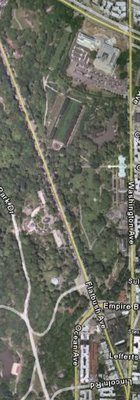
Google Earth satellite photo of the Brooklyn Botanic Garden. North is at the top of the picture. The greenhouses are in the middle right of the photo. Other landmarks: The Brooklyn Museum is the large building at the top of the picture. Prospect Park Zoo is in the middle of the photo, across Flatbush Avenue from BBG. At the bottom of the picture, between Ocean Avenue and Flatbush Avenue, the red-roofed structure is the Prospect Park subway station, the stop I take to get to BBG by subway.

Google Earth satellite photo of the BBG greenhouses and Lily Pool Terrace. The oval glass house at the top of the picture is the Palm Court, used for formal events such as receptions, ceremonies, fundraisers and so on. Below that is the gift shop and offices. I’ve outlined the Bonsai House in green, and the yellow-white dot shows where “Baby” has been located. This and all the other structures in the lower part of the photo comprise the
Steinhardt Conservatory. The large greenhouses on the lower right are the aquatic and other greenhouses. The three octagonal greenhouses are, top to bottom, the
warm temperate,
tropical, and
desert pavilions.

Photo taken from the Lily Pool Terrace, showing the entrance to the Gift Shop, and the Bonsai House. Look at the break in the foliage just to the left of the lamp post. You can see the spadix of A. titanum in the Bonsai House.

Just outside the Bonsai House, the spadix is now clearly visible, as are the visitors inside and outside. You can also see the Web Cam located high on the wall on the right hand side

Inside the Bonsai House, with “Baby” and visitors. This gives you a good sense of scale for the bloom: it’s over 65″ tall, not including the pot!.

View from the other end of the hall, looking back toward the entrance. You can see the Web Cam high on the opposite wall.
Well, campers, it’s now past 2:30am. It’s taken me two hours to put all this together for you. If you’ve read this far, I know you’ve gotten something out of it! Please leave comments with any questions I haven’t answered, or even just to let me know what you liked about all this. It’s been an exciting time. I look forward to the next time when plants and their admiring geeks make news in the larger world, and we can all feel appreciated for our obsessions, at least for a few days.
[bit.ly]
Previous posts:
Links


